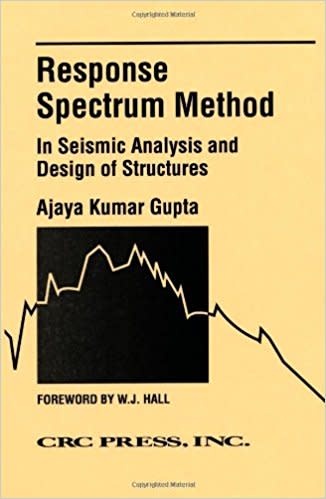Hi KootK,
Your book suggestion is excellent -- it does go into the fundamentals of RSA.
Hi everyone,
I happened to read a few of the earlier thread (I have joined the forum only recently), and happen to come across the thread on doing RSA with P-Delta effects included.
I have often thought about it and concluded it to be impossible (due to the SRSS or CQC kind of combining requirement getting in the way. It is a bitter pill to swallow -- or rather like a coconut to a dog: desirable, but unbreakable.
Anyway, I learned a couple of things there.. primarily that P-Delta can mean either
(1) the P-Delta as I knew it, ie., additional moments developing in the structure by the gravity loads, due to deformation by the lateral loads (as done in STAAD.Pro, in which case the gravity as well as lateral loads are applied together and P-Delta analysis done in a few iterations); or
(2) the reduction of the structure stiffness due to gravity loads (the stress-stiffening and stress-softening effect), and taking mode shapes of the stiffness-reduced structure for RSA (I think ETABS does this).
The 2nd approach above is new to me (and still doubt whether that is what the term 'P-Delta' is meant by) -- only after reading the thread it struck me that this must be what ETABS has the facility for.
Also I'm also not sure which one of the above is intended by the DAM (to me it seems it's the 1st one). There was a suggestion in that thread to analyze for each mode individually and accounting for P-delta effects, and then to combine the modal results as per standard RSA procedures -- though not clear as to which method above it was meant for.
Concerning the 1st one, what I wish to clarify goes like this: if G represents gravity loads and M1, M2 and M3 represents the modal seismic forces, then the design load combination, can be represented (using SRSS instead of CQC for simplicity) as...
Design forces = G + SRSS(M1, M2, M3)
= G + (M1^2 + M2^2 + M3^2)^(1/2)
... (without denoting the factor of Safety). But when each modal forces are solved for, separately of course, if one does that with P-Delta included (the 1st approach above) , it means each of the analysis will have to be done with the gravity loadings on, thus resulting in the above load combination being...
Design forces = SRSS({M1+G}, {M1+G}, {M1+G})
= ({M1+G}^2 + {M1+G}^2 + {M1+G}^2)^(1/2)
... (omitting the G outside the SRSS since it's already included in each modal case) which when expanded will be considerably different from what we started with.
So the question still remains concerning the 1st method: Is there some other approach to include P-Delta?
Rahul Leslie

